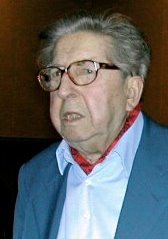
Henri Paul Julien Dutilleux was a French composer of late 20th-century classical music. Among the leading French composers of his time, his work was rooted in the Impressionistic style of Debussy and Ravel, but in an idiosyncratic, individual style. Among his best known works are his early Flute Sonatine and Piano Sonata; concertos for cello, Tout un monde lointain... and violin, L'arbre des songes ; a string quartet known as Ainsi la nuit ; and two symphonies: No. 1 (1951) and No. 2 Le Double (1959).
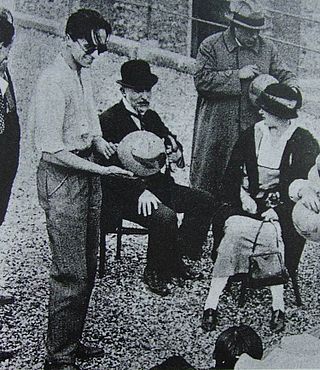
René Clair, born René-Lucien Chomette, was a French filmmaker and writer. He first established his reputation in the 1920s as a director of silent films in which comedy was often mingled with fantasy. He went on to make some of the most innovative early sound films in France, before going abroad to work in the UK and USA for more than a decade. Returning to France after World War II, he continued to make films that were characterised by their elegance and wit, often presenting a nostalgic view of French life in earlier years. He was elected to the Académie Française in 1960. Clair's best known films include Un chapeau de paille d'Italie, Sous les toits de Paris, Le Million (1931), À nous la liberté (1931), I Married a Witch (1942), and And Then There Were None (1945).
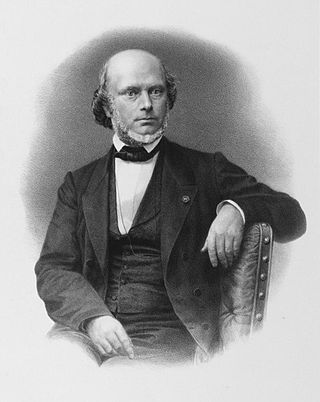
Jean Louis Armand de Quatrefages de Bréau was a French biologist.

Victor Henri Rochefort, Marquis de Rochefort-Luçay was a French writer of vaudevilles and politician. He was born in Paris and died in Aix-les-Bains.

Henri Julien, baptised Octave-Henri Julien, was a Québécois artist and cartoonist noted for his work for the Canadian Illustrated News and for his political cartoons in the Montreal Daily Star. His pseudonyms include Octavo and Crincrin. He was the first full-time newspaper editorial cartoonist in Canada.
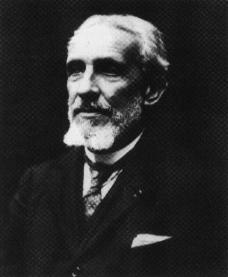
Édouard-Alfred Martel, the 'father of modern speleology', was a world pioneer of cave exploration, study, and documentation. Martel explored thousands of caves in his native France and many other countries, popularised the pursuit of cave exploration, introduced the concept of speleology as a distinct area of scientific study, maintained an extensive archive, and in 1895 founded Société de Spéléologie, the first organisation devoted to cave science in the world.

Henri Hauser was a French historian, geographer, and economist. A pioneer in the study of the economic history of the early modern period, he also wrote on contemporary economic issues and held the first chair in economic history to be established at a French university.

Henri Wittmann is a Canadian linguist from Quebec. He is best known for his work on Quebec French.
Events from the year 1866 in France.
Caressa & Français was a distinguished firm in Paris that specialized in fine musical instruments and bows.

Henri Prost was a French architect and urban planner born in Saint-Denis. He was noted in particularly for his work in Morocco and Turkey, where he created a number of comprehensive city plans for Casablanca, Fes, Marrakesh, Meknes, Rabat, and Istanbul, including transportation infrastructure and avenues with buildings, plazas, squares, promenades and parks.

Nasreddine Dinet was a French orientalist painter and was one of the founders of the Société des Peintres Orientalistes [Society for French Orientalist Painters]. He became so enchanted with North Africa and its culture, that he converted to Islam, and was proficient in Arabic. In addition to his paintings, he translated Arabic literature into French.

The French writer and folklore collector Henri Pourrat was born in 1887 in Ambert, a town in the mountainous Auvergne region of central France. He died near Ambert in 1959.

Henri Paul Royer was a French painter, remembered especially for his genre works from Brittany. A painter of genre, portraitist and landscape artist, he travelled both in America and Europe during his life.

Marcel-André Baschet was a French portrait painter, notable for his numerous portraits of the Presidents of the French Third Republic.
Marie Étienne Pierre Paul Aimé Buffet, known as Étienne Buffet, was a French painter.

Jules-Joseph Guiffrey was a 19th-century French art historian, a member of the Académie des beaux-arts.

The Matador Saluting is an oil-on-canvas painting produced by Édouard Manet between 1866 and 1867. Its precise date is unclear – Charles S. Moffett dates the first definite reference to the work to 1867, at an exhibition devoted to Manet's works at the pavillon de l'Alma.
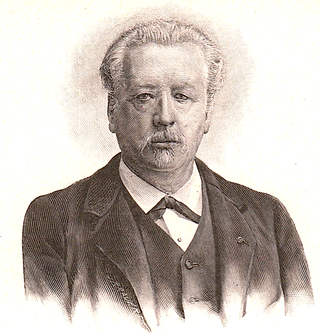
Frédéric-Auguste Laguillermie was a French etcher and painter. He was one of the founders of the Société des aquafortistes français.
Urbain-Louis-Eugène Léger was a French zoologist who was a specialist on aquatic protists, fish parasites, and fish farming. He served as a professor of zoology at Grenoble.
















